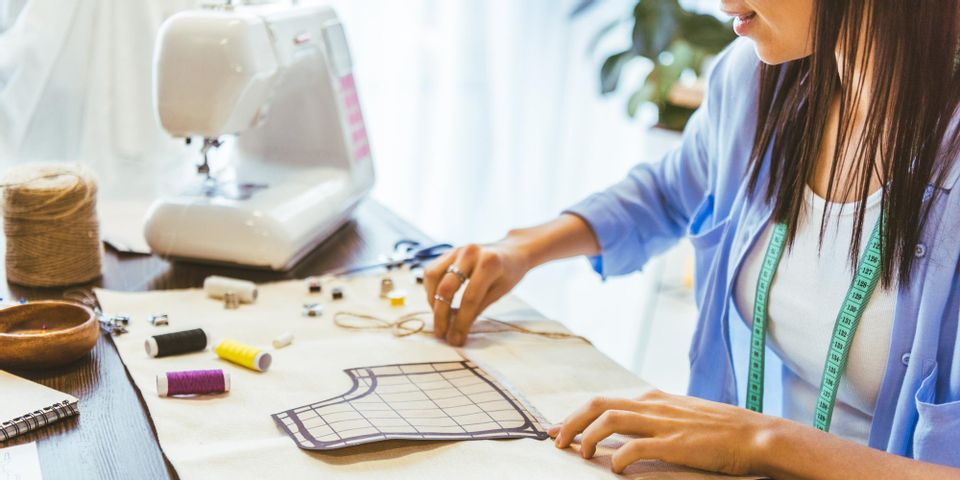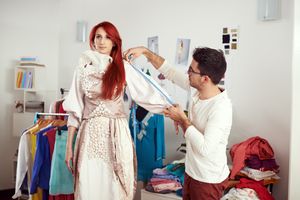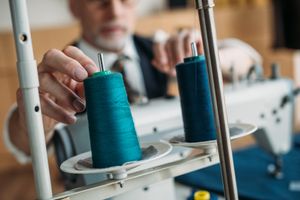
Like with any new hobby, there’s a learning curve that comes with teaching yourself how to sew your own clothes. From preparing the materials involved to utilizing the various components of a sewing machine, there are a handful of mistakes that can compromise your first few garments. Without correcting them, you risk wasting time and effort on harder projects—like those involving spandex—before you’re ready. Here are some common mistakes sewing beginners make, how to avoid them, and how to rescue a project once you’ve made them.
Mistakes Before Sewing
Not Measuring Yourself
 A significant benefit of sewing your own clothes is the custom-tailoring. Since you have control over the measurements of each component of the garment, you must take accurate measurements of your body. With this task, both your inexperience and subjectivity can throw a wrench in your design plans.
A significant benefit of sewing your own clothes is the custom-tailoring. Since you have control over the measurements of each component of the garment, you must take accurate measurements of your body. With this task, both your inexperience and subjectivity can throw a wrench in your design plans.
For beginners, follow a guide that explains what each measurement is and how to measure it accurately. Often, recruiting the help of someone else can make the task a little easier. If you don’t have a sewing assistant on hand, you can pull some critical measurements from a well-fitting piece of clothing that you already own.
Once you have a grip on measurements, you need to have an objective mindset going into the process. Sometimes you can feel tempted to cut off an inch in your measurements because you feel insecure about the size that you are.
In the long run, if you trim an inch here and there, you will end up with a garment that is uncomfortable or doesn’t fit, which defeats the purpose of custom sewing in the first place. If you can’t maintain objectivity, once again ask someone else to do your measurements for accurate results.
Even worse still, don’t avoid measuring altogether in favor of guessing based on your ready-to-wear size. Industry sizing for fashion versus sewing is drastically different, meaning that a sewing pattern may be a larger size number-wise than you’re used to getting. This difference makes measuring even more critical to spare you the disappointment of a garment that doesn’t fit.
Buying a Fancy Sewing Machine as a Beginner
When you start a new hobby, your excitement can cloud your judgment. You want the best equipment to start on the right foot with your new endeavor, but with sewing, top of the line equipment can run you over a thousand bucks. While these fancy computerized machines are stunning—capable of breezing through beginner projects, embroidering, and housing hundreds of decorative stitches—you don’t need to invest in this type of machine when you begin sewing.
Besides not having the skill to take advantage of the offerings of a fancy sewing machine, you should know if you plan on sewing long term before dropping a grand on this hobby. Instead, search for quality—even one with a few bells and whistles—without the hefty price tag. That way, if you discover you don’t have the time to invest heavily in the learning curve for sewing, your bank account isn’t feeling the repercussions.
Choosing a Sewing Pattern Too Difficult for Your Skill Level
To avoid frustration in the first few projects that you attempt as a sewist, start simple. A basic dress or a tote are excellent beginner projects to slowly introduce you to preparing a sewing pattern and using a sewing machine. Getting overly ambitious with a design that requires a ton of alterations, however, will often nip your curiosity for sewing in the bud.
Complicated sewing patterns are frustrating even for experienced sewists, as they can take weeks to finish and have little room for error. Bust alterations, for example, require a lot of variables to make them fit properly, so steer clear until you’re ready to invest the time into a garment that needs them.
Ignoring Fabric Suggestions
Every sewing pattern will include a variety of information about how to bring the piece of clothing to life, including fabric suggestions. The packet will tell you which types they recommend based on the structure and purpose of the garment, including the stretch needed for the material.
While you don’t have to follow these instructions exactly, ignoring them entirely will result in an ill-fitting or poorly structured garment. If the garment calls for spandex, for example, the sewing pattern will be shaped a little smaller so that the final product can take advantage of the stretchy material. When you use a non-stretch fabric with a spandex pattern, it will inevitably come out too small.
Mistakes During Sewing
Using the Wrong Needle
When it comes to putting needle to fabric, not all needles are made equal. Universal ones are typically your best bet, as they can handle a variety of fabrics. For knits and stretch material like spandex, though, you’ll need a ballpoint or stretch needle in your sewing machine.
These special needles have a rounded point that push in between the fabric fibers rather than piercing through them. This distinction is essential for spandex, which will unravel if a sharp point pierces its fibers. Beyond rounded points for stretch fabrics, there are specialty needles of all types and sizes for any project. Regardless of which one you use, make sure to switch out the needle in your sewing machine after every six to eight hours of use.
Misusing Your Presser Foot
Beginners will often forget to set their presser foot to its “down” position before they begin sewing, which can cause many issues with your project. This element of your sewing machine holds the fabric in place as you stitch, and guides the material so that you sew in a straight line. Without it, the fabric can jump around, and you’ll end up with a tangled mess instead of a clean stitch. Add the presser foot to your machine checklist before beginning any garment to save you the effort of ripping messed up seams.
Setting the Wrong Tension
 The tension of the thread is one of the more challenging elements to master when sewing. When it isn’t set correctly, the stitching will be too loose (causing unevenness) or too tight (creating bunching). Practice will help you understand tension settings over time, but as you’re getting the hang of it, always buy extra fabric so that you have scraps to use for testing stitching. That way, you can work out what works best for the material and allow the actual project to run smoothly.
The tension of the thread is one of the more challenging elements to master when sewing. When it isn’t set correctly, the stitching will be too loose (causing unevenness) or too tight (creating bunching). Practice will help you understand tension settings over time, but as you’re getting the hang of it, always buy extra fabric so that you have scraps to use for testing stitching. That way, you can work out what works best for the material and allow the actual project to run smoothly.
Messing Up Your Seams
With sewing clothing, the key to a well-made final product is the seams. The main trick to them, however, is the act of sewing the piece inside out to create the seam. That element becomes essential to remember with patterned fabrics. When piecing your garment together, make sure the patterns on the two pieces are facing each other. This step will assure that the print will show when you turn it right-side-out again.
Making clean seams also requires pressing the fabric both before starting the project and while you go. Steaming or ironing the fabric beforehand assures that you start with smooth textile that has its intended shape. Going in with wrinkled material will result is jagged stitching or cutting and an ill-fitting final product once it eventually sees in iron. Pressing the seams as you go also helps guide straight stitching, so invest that extra time in your garment to get a more professional-looking result.
Before pressing your fabric, read the care instructions carefully. Material like spandex is damaged by an overly hot iron, which can ruin your product with burn marks or unraveling material. Adjust your iron or steamer’s heat settings before getting to work on an unfamiliar fabric.
Now that you know the “don’ts” of sewing, we’ll let you in on a to-do for your next project: start it at Spandex House. With thousands of fabrics to choose from, you’ll find the perfect material to bring your garment to life. For more information and to order samples, visit their website, or call them today at (212) 354-6711
About the Business
Have a question? Ask the experts!
Send your question

